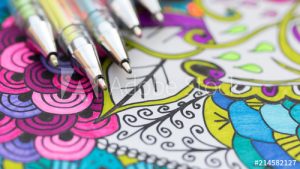Improve Well-Being with Mandala Drawing
By John M. de Castro, Ph.D.
“Mandala means “sacred circle” in Sanskrit, which is a traditional concept employed in meditation and a ritual symbol that represents the universe in Hinduism and Buddism. Today, Mandala has evolved into a powerful art therapy exercise that allows the creator to enjoy some peace and quiet by simply crafting colourful geometric patterns within a circular shape. “ – Helen Yu
Mindfulness practices have been shown to have a large number of beneficial effects on the psychological, emotional, and physical health of the individual and is helpful in the treatment of mental and physical illness. They have also been shown to effect a large number of physiological and psychological processes, including emotion regulation, attention, sensory awareness, decentering, and reappraisal. Mindfulness practices have been shown to be particularly effective in reducing anxiety.
Recently, adult coloring books have become popular as a mindfulness practice. It is thought that immersion in the creative yet structured and safe process of coloring will increase mindfulness and in turn produce the benefits of mindfulness. Mandala drawing is an ancient mindfulness practice. But the effects of mandala drawing on the well-being of participants has not been adequately tested scientifically.
In today’s Research News article “Cooperative and Individual Mandala Drawing Have Different Effects on Mindfulness, Spirituality, and Subjective Well-Being.” (See summary below or view the full text of the study at: https://www.frontiersin.org/articles/10.3389/fpsyg.2020.564430/full?utm_source=F-AAE&utm_medium=EMLF&utm_campaign=MRK_1456740_69_Psycho_20201013_arts_A ) Liu and colleagues recruited healthy college students and randomly assigned them to mandala drawing either alone (individual) or in groups of 4 (cooperative). They met for 5 weekly, 90-minute sessions in which they received training and drew mandalas in provided blank circles. They were measured before and after practice for mindfulness, spirituality, subjective well-being, satisfaction with life, and positive and negative emotions.
They found that neither group had significant increases in mindfulness while both groups had significant increases in spirituality with the cooperative group showing significantly larger increases. They also found that the cooperative condition produced a significant increase in positive emotions and subjective well-being while the individual condition did not. Both groups had significant decreases in negative emotions. They also found that the higher the levels of positive emotions, the higher the levels of mindfulness, spirituality, satisfaction with life, and subjective well-being.
These results are interesting and demonstrate that mandala drawing is beneficial for the psychological health and spirituality of participants. It does not appear that mindfulness mediates these effects as there was no increase in mindfulness produced by either individual or cooperative mandala drawing.
The results show that mandala drawing in a cooperative, group, format produces superior benefits to those produced by individual mandala drawing, including more positive emotions and greater subjective well-being. Since participating in a group can be more fun it would be expected that positive emotions would increase further and the group socialization would reduce loneliness and produce greater subjective well-being. So, it would appear that mandala drawing is beneficial by itself but adding a social component increases the benefits.
So, improve well-being with mandala drawing.
“Each person’s life is like a mandala – a vast limitless circle. We stand in the centre of our own circle, and everything we see, hear and think forms the mandala of our life… everything that shows up in your mandala is a vehicle for your awakening.” ―Pema Chödrön
CMCS – Center for Mindfulness and Contemplative Studies
This and other Contemplative Studies posts are also available on Google+ https://plus.google.com/106784388191201299496/posts and on Twitter @MindfulResearch
Study Summary
Liu C, Chen H, Liu C-Y, Lin R-T and Chiou W-K (2020) Cooperative and Individual Mandala Drawing Have Different Effects on Mindfulness, Spirituality, and Subjective Well-Being. Front. Psychol. 11:564430. doi: 10.3389/fpsyg.2020.564430
Mandala drawing was first practiced by Tibetan buddhists and then developed by Carl Gustav Jung, who felt certain that mandala drawing has the function of integrating psychological division, enhancing psychological harmony, and preserving personality integrity. Previous studies on mandala drawing have mainly focused on alleviating people’s negative emotions, such as anxiety and depression. Therefore, this study explored the effect and mechanism of mandala drawing on the improvement of subjective well-being (SWB), mindfulness, and spirituality from positive psychology’s viewpoint and compared the different effects of cooperative mandala drawing (CMD) and individual mandala drawing (IMD) on mindfulness, spirituality, and SWB. A total of 76 students were recruited from Chang Gung University, and the aforementioned three main variables were measured before and after the coloring experiment. The results indicated that both CMD and IMD significantly enhanced the subjects’ spirituality. Compared with IMD, CMD has a more significant improvement and promotion effect on SWB of subjects by affecting PA, while IMD had no significant effect on PA, and the enhancement effect of SWB was weaker than that of CMD. Mindfulness, spirituality, and SWB all positively correlated with each other. This study highlights the mechanism of mandala drawing and the theoretical understanding of the relationship between mindfulness and SWB. Mandala drawing especially CMD has a positive effect on spirituality and SWB, which may provide individuals with a simple and easy method to improve their happiness.

That was an excellent post! I had no clue Mandalas and meditations were so popular. I’ve been researching and reading a lot about mandalas lately. I’m interested if any of you have any other resources to provide. It appears that finding the most up-to-date information on the website is challenging. I stumbled noticed a handful of relevant websites.https://www.pranalink.com/blog/post/meditation-and-mandala/?utm source=referrer&utm medium=organic is one of the websites. The majority of the website does not update regularly enough to assist me in learning more quickly. Is there anyone willing to assist?